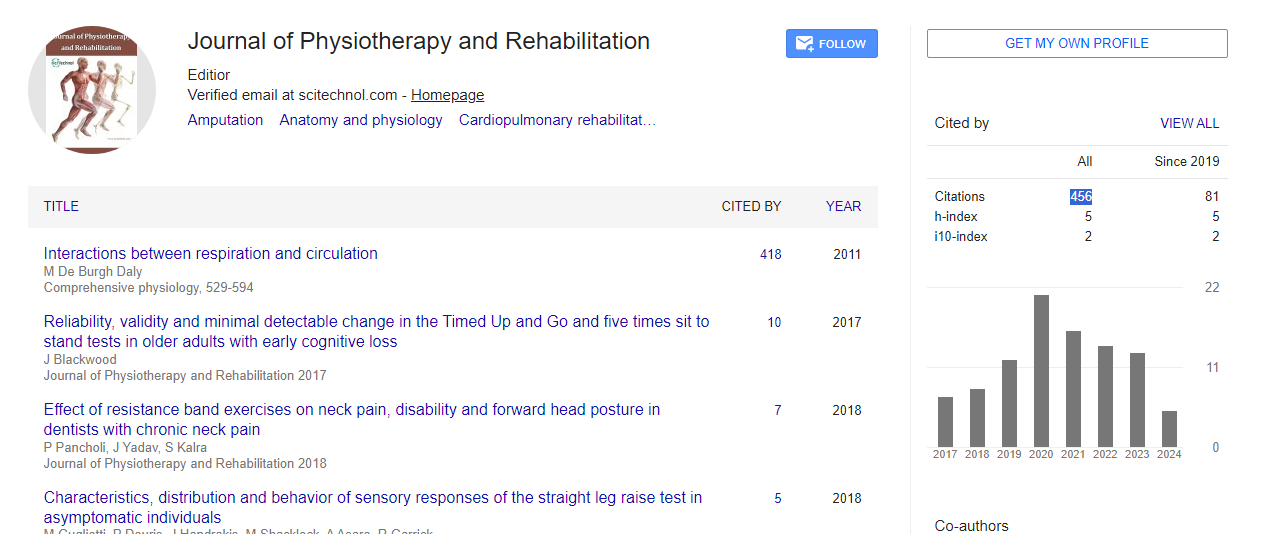Commentary, J Physiother Rehabil Vol: 5 Issue: 12
Risk in Community-Dwelling Older Adults
D. Scott*
Department of Human Life Sciences, University of Tasmania, Launceston, Australia
*Corresponding author: D. Scott, U Department of Human Life Sciences, University of Tasmania, Launceston, Australia, E-mail: d.scott@utes.edu.in
Received date: 01 December, 2021; Accepted date: 16 December, 2021; Published date: 23 December, 2021
Citation: Scott D (2021) Risk in Community-Dwelling Older Adults. J Physiother Rehabi 5:12.
Abstract
This prospective clinical investigation examined the effects of a multidimensional exercise program on balance, mobility, and risk for falls in community-dwelling older adults with a history of falling. Factors used to predict adherence and a successful response to exercise were identified. A total of 105 community-dwelling older adults (≥65 years of age) with a history of two or more falls in the previous 6 months (no neurologic diagnosis) participated. They were classified into a control group of fallers (n=21), a fully adherent exercise group (n=52), and a partially adherent exercise group (n=32). evaluation, each patient received an individualized exercise program addressing the impairments and functional disabilities identified during the assessment.
Keywords: Community-Dwelling, clinical investigation, Older Adults
Description
This prospective clinical investigation examined the effects of a multidimensional exercise program on balance, mobility, and risk for falls in community-dwelling older adults with a history of falling. Factors used to predict adherence and a successful response to exercise were identified. A total of 105 community-dwelling older adults (≥65 years of age) with a history of two or more falls in the previous 6 months (no neurologic diagnosis) participated. They were classified into a control group of fallers (n=21), a fully adherent exercise group (n=52), and a partially adherent exercise group (n=32). evaluation, each patient received an individualized exercise program addressing the impairments and functional disabilities identified during the assessment.
Theme of Older Adults
The control group received no intervention. Changes in performance on five clinical tests of balance and mobility and fall risk were compared among groups. Both exercise groups scored better than the control group on all measures of balance and mobility. Although both exercise groups showed a reduction in fall risk compared with the control group, the greatest reduction was found in the fully adherent exercise group. Factors associated with successful response to exercise included degree of adherence to exercise program and pretest score on the Tinetti Mobility Assessment. Conclusion and Discussion. Exercise can improve balance and mobility function and reduce the likelihood for falls among community-dwelling older adults with a history of falling. The amount of exercise needed to achieve these results, however, could not be determined from this study.
The 1994 Scandinavian Simvastatin Survival Study was the first randomised trial to provide evidence of the benefits of statins (3-hydroxy-3-methylglutaryl coenzyme A, or HMG-CoA reductase inhibitors) for survival in Coronary Heart Disease (CHD) patients. Subsequent clinical trials have demonstrated that statins reduce major coronary events, CHD deaths, requirement for coronary procedures and total mortality, chiefly through lowering concentrations of Low-Density Lipoprotein Cholesterol (LDL-C). A side-effect of statin therapy is myopathy including muscle pain (myalgia) and weakness with or without a concomitant increase in creatine kinase levels. However, as these symptoms can be non-specific and may not always be reported, it is unclear whether this effect is idiosyncratic or occurs to some extent in most statin users. This study was conducted as part of the Tasmanian Older Adult Cohort Study (TASOAC), an ongoing, prospective, population-based study primarily aimed at identifying factors associated with the development and progression of osteoarthritis and osteoporosis in community-dwelling 50- to 80-year-olds. The study was approved by the Southern Tasmanian Health and Medical Human Research Ethics Committee, and written informed consent was obtained from all participants. The cohort consisted of both males and females aged between 50 and 79 years, selected from the roll of electors in southern Tasmania (population 229 000) using stratified simple random sampling without replacement (response rate 57%). The sample was stratified by sex to provide equal numbers of men and women. Institutionalised older adults were excluded. Participants were also excluded due to contraindication for magnetic resonance imaging, as these tests were required to examine osteoarthritis progression.
 Spanish
Spanish  Chinese
Chinese  Russian
Russian  German
German  French
French  Japanese
Japanese  Portuguese
Portuguese  Hindi
Hindi 